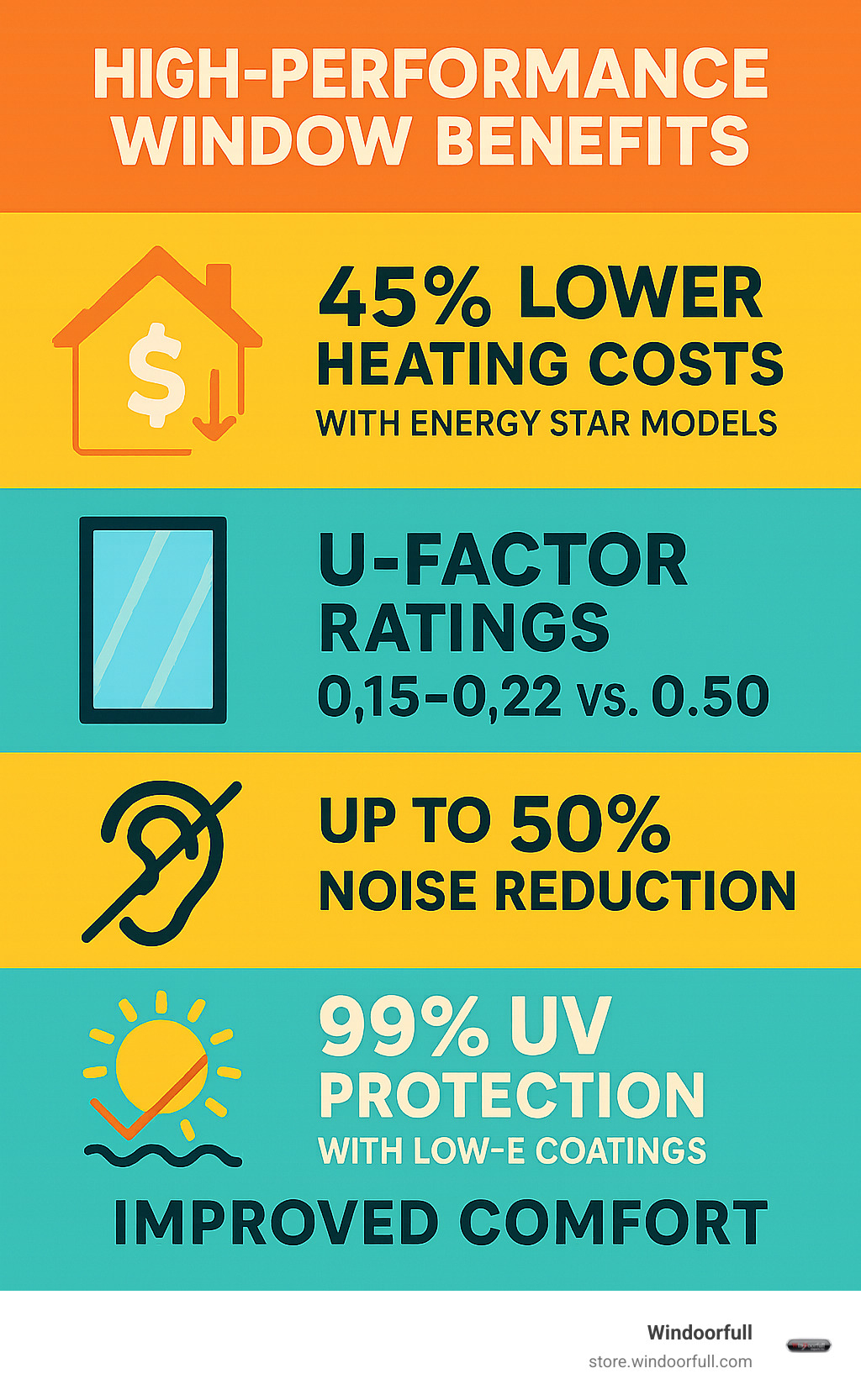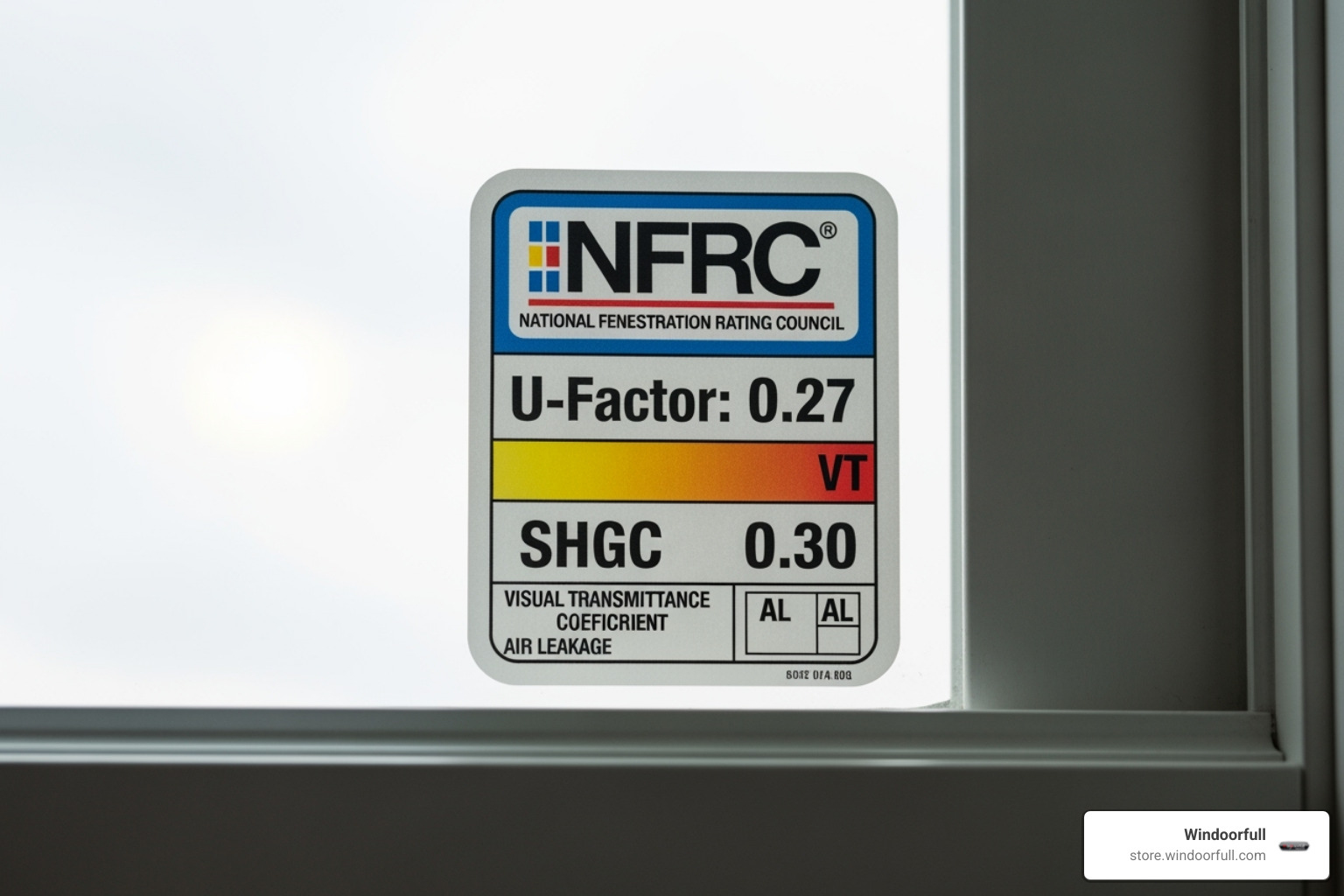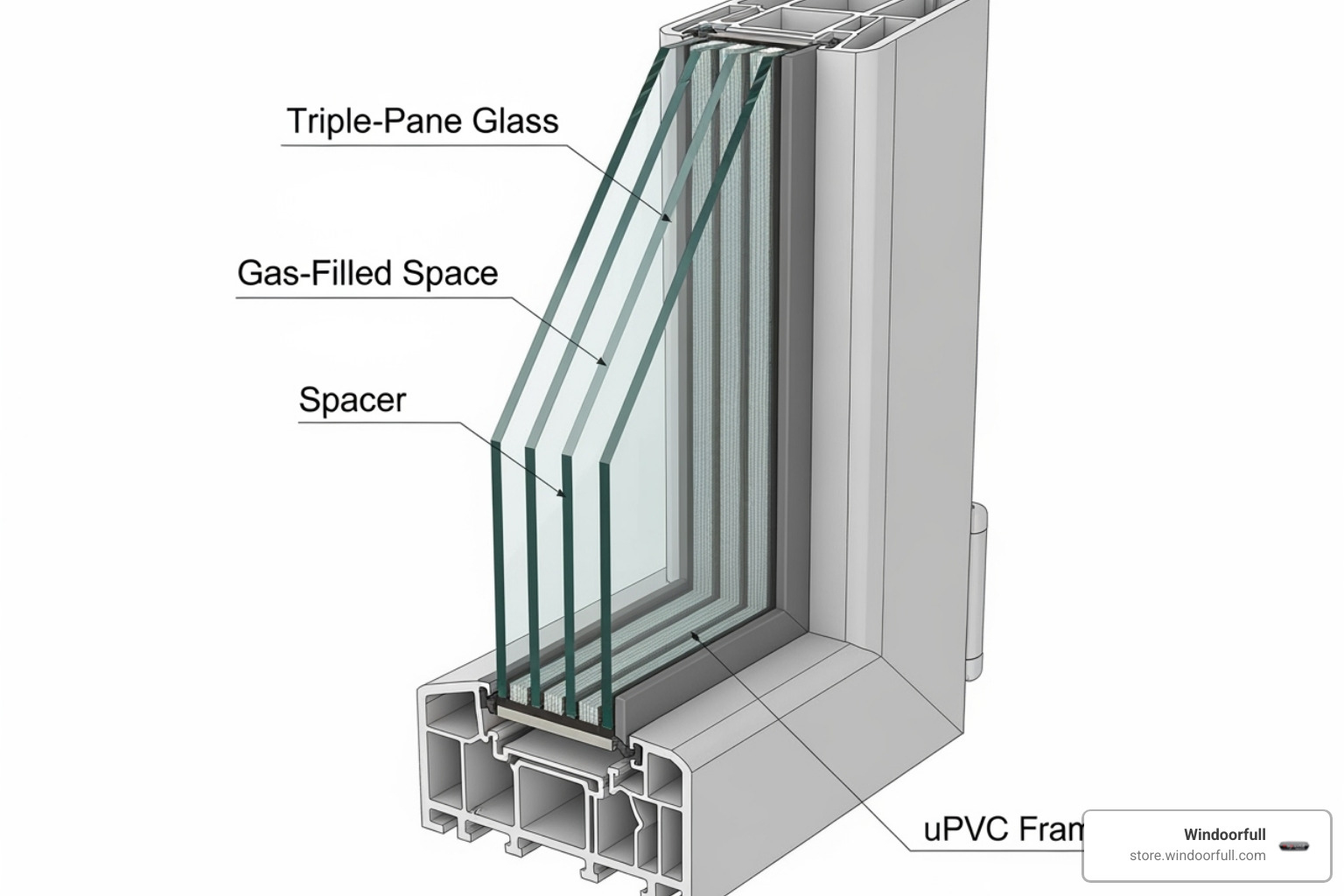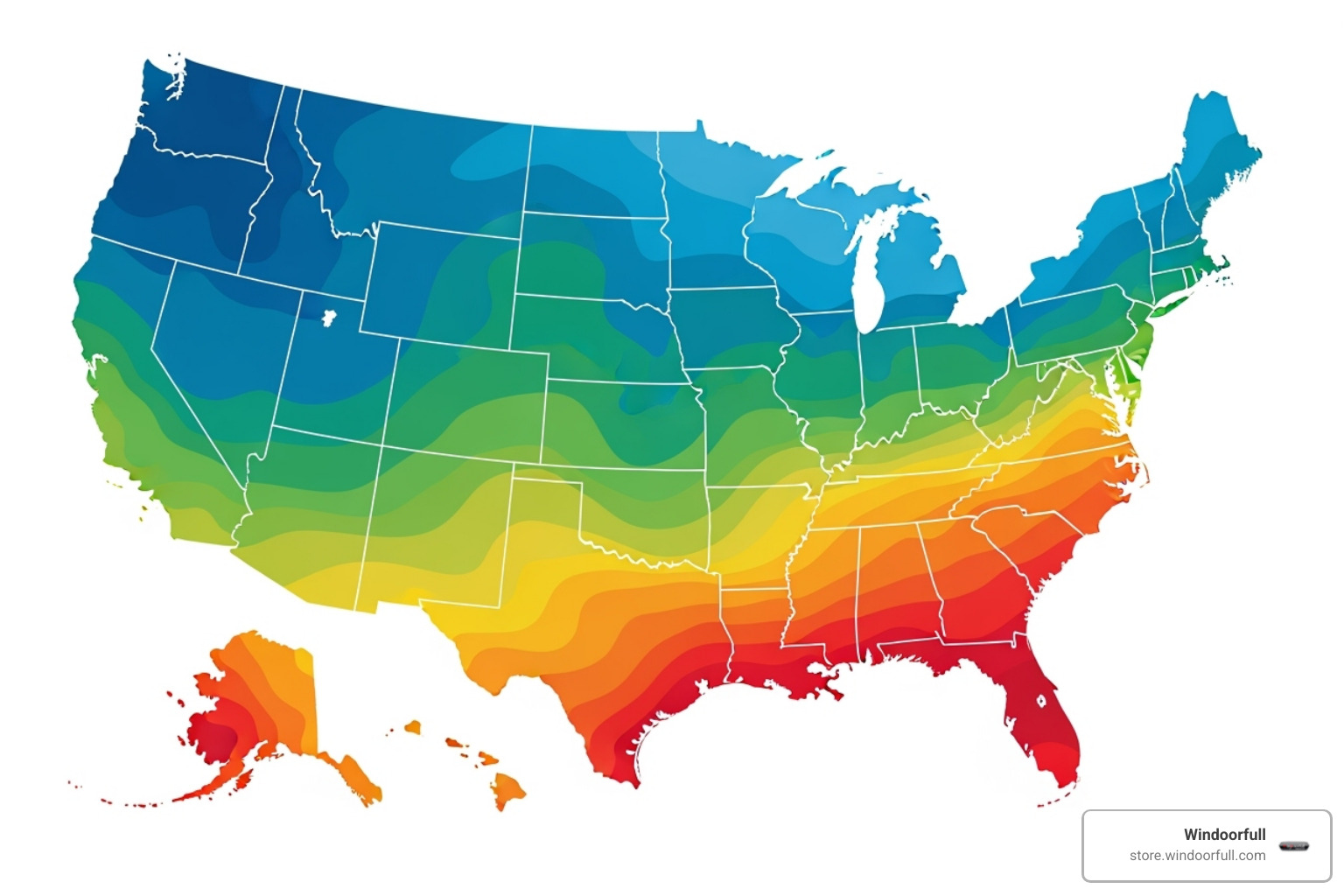
Elevate Your View: Understanding High-Performance Windows
Share
Why High-Performance Windows Transform Your Home
High performance windows are advanced window systems designed to deliver superior energy efficiency, improved comfort, and reduced utility costs through innovative glazing, frame materials, and sealing technologies. Here's what makes them different:
Key Benefits:
- Energy Efficiency - U-factors as low as 0.15 compared to 0.50 for standard windows
- Cost Savings - Up to 45% reduction in heating costs with ENERGY STAR certified models
- Year-Round Comfort - Eliminate cold drafts and hot spots near windows
- Noise Reduction - Up to 50% less outdoor sound transmission
- UV Protection - Low-E coatings block up to 99% of harmful UV rays
Few phrases are thrown around as casually as "high-performance windows," yet there's no single industry standard definition. What we do know is that these windows combine multiple advanced technologies to create a system that's dramatically better than basic builder-grade options.
The difference is striking. A Toronto homeowner who upgraded to triple-pane vinyl windows saw a 38% reduction in monthly heating costs and 60% less temperature fluctuation throughout their home. Even better, they qualified for a $2,800 rebate.
As Wojciech Jagla from Windoorfull Imports Inc., I've spent years helping homeowners understand how European-engineered uPVC and aluminum windows with tilt-and-turn functionality can slash energy costs while delivering best comfort. My experience distributing premium high performance windows has shown me how the right choice transforms both your monthly bills and daily living experience.

What Defines a High-Performance Window?
Here's the thing about high performance windows – there's no official rulebook that says "this is exactly what makes a window high-performance." It's more like a perfect recipe where multiple ingredients come together to create something extraordinary.
Think of your current windows as a basic winter coat. They do the job, sure, but a high performance window is like upgrading to a top-tier expedition parka – engineered with advanced materials and thoughtful design to keep you comfortable no matter what Mother Nature throws your way.
These windows combine superior energy efficiency with advanced technology. They're built to minimize heat transfer, resist air leakage, and create a solid barrier against water, sound, and temperature swings. The result? Dramatically lower energy bills, a quieter home, and consistent comfort year-round.
What makes them special is how all the components work together – the glazing, frame materials, spacers, and sealing systems. Each piece is designed with thermal performance in mind, creating a window system that often exceeds ENERGY STAR requirements and can even meet Passive House standards.
For a deeper dive into this fascinating world, check out A Beginner's Guide to High-Performance Windows.
Decoding the Performance Metrics
Every high performance window comes with what's essentially a report card – the NFRC label. This standardized rating system lets you compare windows fairly, like nutrition labels help you choose between cereals.

The U-Factor is your window's insulation report card. It measures how well the entire window assembly prevents heat from escaping your home. Lower numbers mean better insulation – think of it as your window's ability to keep your expensive heated or cooled air where it belongs. High-performance windows typically have U-factors between 0.15 and 0.30, compared to standard windows that often score around 0.50.
Solar Heat Gain Coefficient (SHGC) tells you how much solar heat passes through your window. In hot climates, you want a low SHGC (around 0.25) to keep summer heat out. In colder regions, a higher SHGC (around 0.40) can actually help warm your home naturally during winter.
Visible Transmittance (VT) measures how much natural light comes through – because nobody wants energy efficiency at the cost of living in a cave. Higher numbers mean brighter, more cheerful interiors.
Air Leakage (AL) ratings show how much unwanted air sneaks through your windows. ENERGY STAR certified windows must have an AL of 0.3 or lower – meaning virtually no drafts.
Condensation Resistance rates how well your windows resist fogging up on cold mornings. Higher numbers mean clearer views and less moisture problems.
You can learn more about reading these important ratings at Read the NFRC label.
How Metrics Impact Your Home
Now here's where these numbers translate into real-world benefits you'll actually notice every day.
Energy savings happen when your windows have the right ratings for your climate. A proper U-factor keeps your heating costs down in winter, while the right SHGC prevents your air conditioner from working overtime in summer. Many homeowners see 30-50% reductions in energy costs – money that stays in your pocket instead of flowing to the utility company. It's exactly what we talk about in The Power of Pennies: Simple Steps to Reduce Your Energy Bills.
Year-round comfort means no more cold drafts making you shiver by the window in January, or hot spots that force you to crank up the AC in July. High performance windows create consistent temperatures throughout your home, so you can actually use that reading nook by the window year-round.
Reduced HVAC strain is like giving your heating and cooling system a break. When your windows do their job properly, your furnace and air conditioner don't have to work as hard. This means lower energy bills, fewer repairs, and equipment that lasts longer. Some homeowners even find they can downsize to a smaller, less expensive HVAC system.
Protecting furnishings from UV fading becomes automatic with Low-E coatings that block up to 99% of harmful UV rays. Your hardwood floors, furniture, and artwork stay vibrant and beautiful for years longer. It's like having invisible sunscreen for your entire home.
Quieter home interior might be the most surprising benefit. Triple-pane high performance windows with gas fills act like sound barriers, reducing outside noise by up to 50%. Traffic sounds, barking dogs, and neighborhood noise stay where they belong – outside.
The Anatomy of High-Performance Windows
Think of a high performance window like a well-orchestrated symphony. Each component—the glazing, frame materials, hardware, and spacers—plays its own part, but the magic happens when they all work together in perfect harmony. Remove or compromise one element, and the entire performance suffers.

The beauty of modern window engineering lies in how these components complement each other. A superior glazing system paired with a poorly insulated frame is like wearing a winter coat with shorts—you're only half-protected. That's why understanding each component helps you make smarter decisions about your home's comfort and energy efficiency.
The Power of Glazing: More Than Just Glass
Your window's glazing takes up about 80% of the total window area, so it's no surprise that this is where most of the thermal magic happens. But today's high performance windows go far beyond simple glass panes.
Double-pane glass has become the baseline for any energy-conscious homeowner. Two glass panes separated by an insulating air space create a thermal barrier that dramatically outperforms old single-pane windows. It's like adding a cozy sweater to your window opening.
Triple-pane glass takes this concept even further. With three panes and two insulating spaces, these glazing units can achieve U-factors as low as 0.15—compared to 0.50 for standard double-pane units. The difference is remarkable: less heat loss, better sound dampening, and virtually no condensation issues. If you're curious about whether the upgrade is worth it, Beyond Double: Is Triple Glazing the Smart Choice for Your Home? explores this question in detail.
Low-E coatings are the invisible heroes of modern glazing. These microscopically thin metallic layers reflect radiant heat while allowing visible light to pass through. In winter, they bounce your indoor heat back inside. In summer, they reflect the sun's heat away from your home. Plus, they block up to 99% of harmful UV rays that fade your furniture and flooring.
The spaces between glass panes aren't just filled with regular air anymore. Argon gas fill is denser than air, which slows down heat transfer and boosts insulation performance. It's a cost-effective upgrade that makes a noticeable difference in energy bills.
For the ultimate in thermal performance, Krypton gas fill offers even better insulation, especially in the narrower spaces found in triple-pane units. While more expensive than argon, krypton delivers superior results in extreme climates where every bit of efficiency counts.
Frame Materials and Their Impact on Performance
Here's something many homeowners don't realize: even the best glazing can't save a window with a poorly designed frame. The frame forms the structural backbone and thermal envelope of your entire window system. Choose the wrong material, and you'll have thermal bridges that let heat escape faster than you can say "energy bill."
uPVC windows have earned their reputation as thermal champions for good reason. These multi-chambered profiles create insulating air pockets throughout the frame structure. Unlike metal frames, uPVC doesn't conduct heat, so there's no pathway for energy to sneak through. The material itself resists rot, corrosion, and insect damage while requiring virtually no maintenance. No painting, no staining, no annual upkeep—just decades of reliable performance.
Wood frames offer natural insulation properties and timeless appeal, but they demand significant maintenance to prevent moisture damage, rot, and warping. While beautiful, wood requires regular painting, staining, or sealing to maintain both appearance and performance over time.
Thermally broken aluminum frames solve traditional aluminum's heat conduction problem by inserting non-metallic barriers within the frame structure. This interrupts the thermal bridge while maintaining aluminum's strength and durability. However, achieving the same thermal performance as uPVC typically costs considerably more.
| Feature | uPVC | Wood | Thermally Broken Aluminum |
|---|---|---|---|
| Insulation | Excellent multi-chambered design prevents heat transfer | Good natural insulation, varies with wood density | Good thermal break technology reduces conduction |
| Maintenance | Very low - no painting or sealing needed | High - requires regular painting and sealing | Low - resistant to corrosion but can scratch |
| Durability | Excellent 30-40+ year lifespan, weather resistant | Good if maintained, susceptible to moisture damage | Excellent strength and corrosion resistance |
| Cost | Moderate with excellent long-term value | High, especially for quality materials | High initial investment |
The frame choice impacts more than just energy efficiency—it affects your home's security too. For insights into how frame construction contributes to overall window strength and protection, Beyond the Pane: Choosing High-Security Windows for Ultimate Protection offers valuable guidance on this important topic.
Selecting the Right Windows for Your Home
Picking the perfect high-performance windows is like choosing the right jacket for your climate—you wouldn't wear a heavy winter coat in Miami, right? Your windows need to match your local weather patterns, your home's style, and your family's needs.
The good news? You don't have to guess what works best. There are proven guidelines to help you make the smart choice, and proper installation plus simple maintenance will keep your investment paying off for decades.
Matching Windows to Your Climate with ENERGY STAR
Think of ENERGY STAR as your personal window shopping assistant. This government program has done the homework for you, creating performance standards based on what actually works in different parts of the country.

The United States is divided into four main climate zones, each with its own window personality requirements.
Northern climate needs focus on keeping precious heat inside during those brutal winters. Here, you want windows with very low U-factors—think of them as thermal blankets for your home. A higher Solar Heat Gain Coefficient (SHGC) on south-facing windows can actually help, letting the winter sun warm your house naturally and reducing your heating bills.
Southern climate needs are all about blocking that intense heat and sun. In these regions, you want windows with low SHGC ratings to keep solar heat out, while still maintaining good U-factors for overall insulation. Your air conditioner will thank you.
Many high-performance windows are overachievers—they meet standards for multiple climate zones, giving you flexibility if you move or if your local weather gets unpredictable. Always check that ENERGY STAR label to make sure your windows are certified for your specific area. You can find your ENERGY STAR® climate zone here to get the exact requirements for your location.
Choosing the Best Window Type for Your Needs
Now comes the fun part—picking the style that fits your home and lifestyle. Each window type has its own superpowers when it comes to performance and functionality.
Casement windows are the overachievers of the window world. They crank open outward, giving you fantastic ventilation and unobstructed views. When they close, the sash presses firmly against the frame like a tight hug, creating one of the most airtight seals you can get in an operable window.
Picture windows are the strong, silent type. Since they don't open, they have no moving parts to leak air through. This makes them the most energy-efficient option by design—perfect for showcasing a beautiful view while keeping your energy bills low.
European tilt and turn windows are like the Swiss Army knife of windows. They tilt inward from the top for gentle, secure ventilation, or swing fully inward like a door for maximum airflow and easy cleaning. Their multi-point locking systems and superior seals make them excellent high-performance windows. We truly believe they're the smart choice for modern homes: Why Tilt and Turn Windows Belong in Your USA Home.
Awning windows hinge at the top and open outward from the bottom, creating a little canopy. This clever design lets you get fresh air even during light rain, and they seal tightly when closed, similar to casement windows.
When you're weighing your options, consider both how you'll use the windows and their performance characteristics. For a detailed comparison of popular styles, check out Which Window Wins? Tilt and Turn vs. Casement Explained.
The Critical Role of Installation and Maintenance
Here's the truth: even the most advanced high-performance window can become an expensive disappointment if it's not installed properly. It's like buying a Ferrari and letting your teenager change the oil—some things are worth doing right.
Professional installation is absolutely crucial. A skilled installer ensures your window sits perfectly plumb, level, and square in the opening. More importantly, they know how to properly seal the window into your home's building envelope. Those gaps around the frame? They can waste more energy than you'd think, turning your high-performance investment into an expensive draft.
Air sealing happens during installation and involves carefully filling gaps between the window frame and wall opening. Professional installers use low-expansion foam and quality sealants to create an airtight barrier. This step is invisible once it's done, but it's what separates a truly efficient installation from a mediocre one.
Once your windows are installed, keeping them performing at their best is surprisingly simple. Weatherstripping around the moving parts should be checked annually—look for cracks or wear that might let drafts sneak in.
Weep hole cleaning sounds fancy, but it's just keeping those tiny drainage holes clear of leaves and debris. These little holes let any moisture that gets into the frame drain out safely. A quick check once a year prevents water problems down the road.
Frame maintenance is where uPVC windows really shine. Unlike wood windows that need regular painting and sealing, uPVC frames just need occasional cleaning with mild soap and water. They won't rot, warp, or fade, making them incredibly low-maintenance.
Hardware lubrication keeps everything moving smoothly. A little silicone spray or white lithium grease on hinges and locks once a year ensures your windows open and close effortlessly for decades.
The bottom line? Invest in professional installation and spend a few minutes each year on basic maintenance. Your high-performance windows will reward you with consistent comfort and energy savings for 30 years or more.
Frequently Asked Questions about High-Performance Windows
When homeowners start exploring high performance windows, they often have similar concerns and curiosities. Let me address the questions I hear most frequently, drawing from years of helping families make this important investment.
Are high-performance windows worth the investment?
This is probably the most common question I get, and my answer is always an enthusiastic yes! While high performance windows do require a bigger upfront investment than basic builder-grade options, the long-term benefits make them one of the smartest home improvements you can make.
Think about it this way: your windows will be part of your home for decades. Over that time, you'll see significant long-term energy savings through reduced heating and cooling bills. Many homeowners save hundreds or even thousands of dollars annually on utility costs.
But the benefits go well beyond your monthly bills. These windows increase your home value substantially - energy-efficient features are at the top of modern homebuyers' wish lists. You'll also enjoy dramatically improved comfort with consistent temperatures throughout your home, no more cold drafts in winter or hot spots near windows in summer.
The durability factor is huge too. European-engineered windows like our uPVC models are built to last 30-40 years or more, far outlasting standard windows. Plus, you'll love the quieter home environment - many customers tell me they had no idea how much street noise they were living with until they upgraded.
The payback period varies depending on your climate, local energy costs, and which windows you choose. But honestly, most families find the improved comfort and peace of mind make the investment worthwhile long before they've recouped the full cost through energy savings.
What is the difference between U-Factor and R-Value?
I get this question a lot because both terms pop up when discussing insulation, and they can seem confusing at first. The good news is they're actually measuring the same thing, just from opposite perspectives.
U-Factor measures heat transfer - specifically, how much heat moves through your window. Think of it as measuring how "leaky" your window is thermally. A lower U-Factor means less heat escapes, which is what you want.
R-Value measures resistance to heat flow - essentially, how well your window blocks heat from moving through it. A higher R-Value means better resistance, which is good.
Here's the key: they are mathematical reciprocals, meaning R-Value equals 1 divided by U-Factor (and vice versa). So if your window has a U-Factor of 0.25, its R-Value would be 4 (1 ÷ 0.25 = 4).
When shopping for windows, just remember: lower U-Factor is better, higher R-Value is better. Both tell you the same story about your window's insulating ability, just using different numbers.
Can I get high-performance features in any window style?
Absolutely! This is one of the best things about modern high performance windows - you don't have to choose between the style you love and the efficiency you need. Most manufacturers offer performance packages with advanced glazing, Low-E coatings, gas fills, and improved frame designs across their entire range of window styles.
That said, some window types are naturally more efficient than others. Casement and picture windows are typically most efficient because they create exceptionally tight seals. Picture windows, being fixed, have no moving parts to potentially leak air, making them the ultimate performers.
Tilt and turn windows offer superior air sealing thanks to their unique European engineering and multi-point locking systems. Their innovative design creates remarkably tight seals while offering incredible versatility - they tilt inward for secure ventilation or swing open like doors for maximum airflow and easy cleaning.
It's true that operable windows have slightly lower ratings than fixed ones simply because moving parts require seals that can potentially allow tiny amounts of air leakage. However, modern engineering has narrowed this gap dramatically. Today's high-quality operable windows perform nearly as well as fixed units, so you can choose based on your functional needs and aesthetic preferences without sacrificing efficiency.
The bottom line? Whether you prefer traditional double-hung windows, expansive picture windows, or the versatile functionality of European tilt-and-turn designs, you can find high-performance options that deliver both the look you want and the energy savings you need.
Conclusion
Your journey through high-performance windows shows just how much these advanced systems can transform your daily life. We've explored everything from the technical side—U-factors, SHGC ratings, and Low-E coatings—to the practical benefits that matter most: lower energy bills, year-round comfort, and a quieter home.
The numbers tell a compelling story. When you upgrade to high-performance windows, you're not just buying new glass and frames. You're investing in long-term energy savings that can reduce your heating costs by up to 45%. You're choosing increased home value that today's buyers actively seek out. Most importantly, you're creating a more comfortable living space where drafts disappear and temperature swings become a thing of the past.
At Windoorfull, we've built our reputation on bringing you the superior insulation and versatile functionality of authentic European engineering. Our uPVC windows combine the thermal efficiency of multi-chambered frames with the convenience of tilt-and-turn operation—giving you both performance and practicality in one smart package.
The European engineering behind our windows isn't just about impressive technical specifications. It's about creating windows that work seamlessly in American homes, delivering American-friendly prices without compromising on the quality standards that European manufacturers are known for worldwide.
When you choose high-performance windows, you're making a decision that pays dividends for decades. Every month when your energy bill arrives, every quiet morning when outside noise stays outside, and every comfortable evening when your home maintains the perfect temperature—you'll appreciate this smart investment.
Ready to experience what truly efficient windows can do for your home? Explore our collection of high-performance uPVC windows and find how European engineering can transform your American home into the comfortable, energy-efficient sanctuary you deserve.
